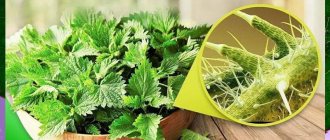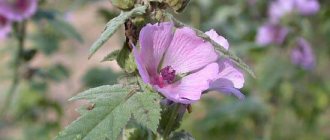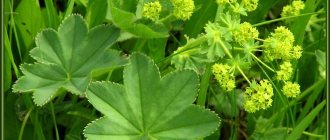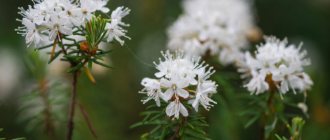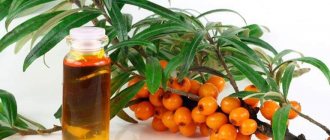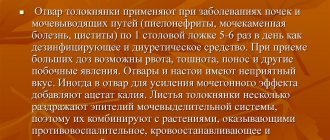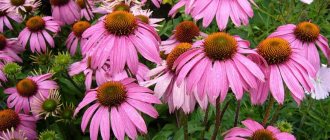Aralia Manchurian medicinal properties contraindications tincture root application photo preparations extract honey care planting description related species
Latin name: Aralia mandshurica Rupr. et Maxim
Other names: Thorn tree, devil's tree, devil's club. Almost all of its popular names are associated with the presence of sharp thorns on the stems, especially in young plants.
Family Araliaceae
Rod Aralia
Aralia Manchurian
What does aralia look like and where does it grow?
Manchurian Aralia (Aralia mandshurica) is a plant from the Araliaceae family, which can also be found under the names devil's tree or thorn tree. It has a straight trunk up to 12 m high, densely studded with numerous sharp spines.
The root system of Aralia is superficial, in the immediate vicinity of the trunk it is located horizontally, but at a distance of 2-3 m it bends sharply and goes down to 60 cm. The leaves of the tree are large, up to 1 m in length, with a complex pinnate structure.
Under natural conditions, Aralia is often the first to colonize cutting areas and burnt areas.
In July and August, Manchurian Aralia produces small white or cream-colored buds in branched inflorescences at the top of the trunk. In September and October it bears fruit - blue-black berries with five seeds inside.
Important! In nature, Manchurian Aralia blooms from the fifth year of life.
The plant is widespread in China, Korea and Japan, on the Kuril Islands, Sakhalin and Primorye, in the Far East. Grows in coniferous and mixed undergrowth in clearings and forest edges at altitudes up to 2700 m above sea level. Situated both singly and in groups.
Spreading
Aralia Manchurian is a Manchurian floristic element, being a relict plant and endemic (that is, found in a small area in only one region of the globe) of the flora of the Far East. It grows in the southeast of the Amur region, in the southern part of the Khabarovsk Territory and almost throughout the Primorsky Territory. The northern border of the range runs between 45-50° N. w. along the middle reaches of the Amur and the lower reaches of its left tributaries, penetrating west to the southern part of the Bureinsky ridge, and east to the village. Innokentyevka, Nanai district, Khabarovsk Territory. From here, the border of the Aralia range descends to the south, runs along the western slope of Sikhote-Alin, bending around it to the south of Mount Cloudnaya, then rises steeply along the sea coast, penetrating north to almost 46° N. w. It grows singly or in small groups on the edges and clearings up to an altitude of 700 m above sea level.
Aralia Manchurian photo
Habitats
Within the delineated range, Aralia Manchurian is found in significant quantities only in the cedar-broad-leaved forests of the southern and middle Sikhote-Alin and in their derivatives, i.e. in secondary phytocenoses that developed on the site of these forests that disappeared due to fires and logging. In real cedar-broad-leaved forests it occurs singly or in small groups, exclusively in cleared areas. When the natural vegetation cover of pine-deciduous forests is disturbed and in areas with unformed vegetation cover, Manchurian Aralia forms relatively large thickets, where its vegetative and often seed reproduction is always observed. Aralia Manchurian is a pioneer in the settlement of burnt areas and cutting areas that arose on the site of cedar-broad-leaved forests. In burnt areas, it often appears in large quantities just a few months after the fire, but after 5-10 years the number of its individuals per unit area sharply decreases as a result of self-thinning. However, due to the rapid growth of plants, its thickets remain quite dense and sometimes impassable. About 20 years after a fire in cedar-deciduous forests, Manchurian Aralia usually disappears completely, remaining only on roadsides, edges and clearings. In subsequent years.
Growing conditions
Prefers fertile soils and open areas. This is a light-loving plant; found in cedar-broad-leaved forests in small groups or individually in cleared areas. When the natural cover is disturbed after logging or fires, it forms relatively large thickets within 2-3
It is better to choose a place for planting aralia somewhere in a corner or near a fence. It is very decorative both in summer and autumn. But keep in mind that the plant gradually grows in different directions and actively “conquers” the adjacent territory, and if it is neighboring, a conflict may arise.
Reproduction
Aralia is propagated by seeds and vegetative root cuttings and root suckers. It is quite difficult to obtain seedlings from seeds, therefore, if it is possible to obtain planting material, we recommend the vegetative method of propagation for amateurs. Seed propagation is a very troublesome and thankless task.
Manchurian aralia seeds lose their viability relatively quickly. Therefore, it is not recommended to store them for more than one and a half years. They don't germinate well. To obtain seedlings in the year of sowing, they must be stratified at variable temperatures or treated with gibberellin. The optimal time for stratification is 3-4 months at a temperature of 14-20 °C and 4 months at a temperature of 2-5 °C.
The most effective way of pre-sowing seed preparation should be the use of a gibberellin solution at a concentration of 0.05% for 2 days, followed by two months of stratification at a temperature of about 0 °C. After treatment, the seeds are washed with tap water and kept for 1 to 3 months at a temperature of 18-20 ° C until germination. Early spring sowing is carried out at the end of April with stratified seeds. Freshly harvested seeds can also be sown in the fall (early September) to a depth of 1.5-2 cm. The distance between holes is 50-60 cm. After sowing, the rows are sprinkled with humus or peat chips mixed with soil. In this case, seedlings appear the next year.
The area intended for sowing or planting Manchurian aralia must be flat in relief, with fertile, structural, sufficiently moist soils. But at the same time, water should not stagnate on it in the spring. In the fall, manure or compost is added to the digging at the rate of 6 kg/m2.
Root cuttings and rhizome segments are best planted in early spring before renewal buds grow. The depth of embedding should not exceed 4-5 cm. Root shoots are planted in the spring in prepared planting holes (similar to fruit crops), well filled with an organo-mineral mixture per hole: 4 kg of rotted manure or compost and 30-50 g of nitroammophosphate.
Care
Caring for aralia consists of loosening (3-4 times), especially in the first years, weeding and fertilizing with nitroammophos (20-30 g for each plant).
Loosening must be very superficial, otherwise the root system is severely damaged. Plants grow poorly, do not bloom or bear fruit, do not form shoots and gradually die. It’s better not to even hoe the surface of the soil, but simply pull out the weeds and mulch the area with a layer of compost every fall.
Aralia needs feeding with nitroammophoska at the rate of 20-30 g for each plant. It responds well to organic feeding with slurry during the growing season: in early spring and during budding.
Chemical composition
The medicinal raw material is a root containing triterpene glycosides - aralosides A, B and C; alkaloids aralin, choline, as well as proteins, starch, carbohydrates, essential oil, tannins and mineral salts.
Active ingredients
The roots, especially their bark, contain triterpene glycosides - aralosides A, B and C, which are derivatives of oleanolic acid. Araloside A predominates, which is oleanolic acid with sequentially attached glucose, arabinose and glucuronic acid residues. The amount of aralosides should be at least 5%. In addition, it contains essential oil, aralin alkaloid, resins, trace elements, glycosides and saponins.
The branches and leaves contain carbohydrates, essential oil, flavonoids, alkaloids, triterpenoids, organic acids and anthocyanins. The seeds contain unsaturated fatty acids (linoleic, octadecenoic).
The underground part of Schmidt's aralia contains the same aralosides A, B and C, among which araloside A also predominates.
Chemical composition
The use of Manchurian Aralia berries and other parts is in demand in folk medicine due to the rich composition of the raw materials. Fruits, leaves, bark and roots contain:
- vitamins B1 and B2;
- ascorbic acid;
- gum;
- potassium, iron and calcium;
- alkaloids;
- copper and molybdenum;
- essential oils;
- starch;
- steroids;
- coumarins and saponins;
- flavonoids;
- organic acids;
- cerebrosides;
- triterpenoids;
- oleanolic acid;
- aliphatic hydrocarbons.
Many components in the plant have toxic properties. Therefore, medicinal preparations of Manchurian aralia require careful use.
Active ingredients
The medicinal characteristics of aralia are based on the diverse chemical composition of the plant. Here are the main operating components of culture:
- Starch - quickly reduces cholesterol. Normalizes blood pressure.
- Essential oils – provide antiseptic, anti-inflammatory effects. The plant calms and relieves spasms.
- Phytosterols – promote the production of vitamin D. Steroid hormones and necessary bile acids appear.
- Flavonoids – relieve spasms. The capillaries are strengthened and the heart muscle is nourished. Blood pressure is normalized, it has a diuretic effect, and the blood stops.
- Resins - guarantee antibacterial, mild laxative and wound healing effects.
- Vitamin C is a powerful antioxidant that improves immunity.
- Tanning components – provide an astringent effect, remove inflammation.
Contains vitamins and microelements. The products give an excellent effect.
Medicinal properties of Manchurian aralia
When used correctly, the plant tincture and other medicines are beneficial for acute and chronic ailments. Namely:
- strengthen the immune system and prevent the development of viral diseases;
- increase efficiency and energy;
- relieve fatigue and normalize night sleep;
- accelerate recovery from serious illnesses;
- reduce blood sugar levels;
- normalize hormonal levels in women;
- accelerate metabolic processes in the body and improve digestion;
- have a beneficial effect on libido in men;
- have an antiseptic effect and help fight germs and infections;
- reduce the level of bad cholesterol and protect the liver from diseases.
Among the indications for the use of aralia in homeopathy is hypotension - plant-based remedies increase blood pressure.
Aralia tinctures and decoctions can be used to increase endurance and prevent heart attacks.
Medicinal properties of aralia root
The largest amount of valuable substances is concentrated in the roots of the plant. It is on their basis that healing tinctures and decoctions are most often prepared. The underground part contains tannins and gum, essential oils and vitamin C.
Remedies from aralia root are used for inflammatory ailments, intestinal disorders and poisoning. Using preparations based on raw materials, lesions and irritations on the skin are disinfected.
What is Manchurian Aralia tincture used for?
The alcohol tincture is valued primarily for its strong anti-inflammatory properties. It is used internally and externally for viruses and infections, for rapid healing and disinfection of wounds.
In addition, the tincture is in demand for anemia and asthenia due to its high content of vitamins. It can be used to speed up blood circulation, to normalize sugar levels, for vegetative-vascular dystonia and malfunctions of the thyroid gland.
Benefits for women
Manchurian aralia is recommended for use for cystitis in women as an anti-inflammatory agent. It can be used in cases of hormonal imbalances and the onset of menopause; the plant improves overall well-being and helps avoid dangerous complications.
Aralia decoctions and infusions are used in cosmetology. Therapeutic products tone the skin and restore its softness, and also stimulate hair growth.
Benefits for men
The use of Schmidt, Manchurian and high aralia is indicated for men at the first signs of impotence. The plant accelerates blood circulation and restores normal functioning of the reproductive system. Aralia has an invigorating effect and helps with heavy physical and emotional stress.
You can take plant preparations to cleanse and protect the liver. Aralia tincture for men is recommended for strengthening blood vessels and preventing myocardial diseases.
Aralosides A, B, C
According to microscopy of the Manchurian Aralia root, its bark consists of parenchyma cells with thin walls, and in its outer part there are calcium oxalate crystals and a thin layer of cambium. But the most important thing is that the main components of the root are aralosides A, B and C, which can increase excitability and physical activity, and can also relieve the inhibitory effect of chlorpromazine. They are also able to influence the heart muscle, increasing its tone, increasing strength and reducing heart rate. Moreover, these aralosides can be purchased in the form of tablets, which should be taken orally to get rid of asthenia, depression, asthenodepressive state, low blood pressure, the first stages of atherosclerosis, and post-traumatic disorder.
Methods of preparation and use
Traditional medicine offers several proven recipes using Manchurian aralia. Plant-based products are suitable for internal and external use.
Aralia tincture recipe
A strong tincture is prepared from the dried roots of the plant. Traditional medicine offers the following recipe:
- 40 g of dry raw materials are poured with a glass of medical alcohol 70%;
- when closed, put away in a dark place for two weeks;
- filter through cheesecloth to remove sediment.
The finished product is consumed 35 drops three times a day with meals.
Advice! Aralia increases blood pressure, so for hypertension, the dosage is reduced to ten drops, and the tincture is taken twice a day.
It is recommended to take Aralia tincture for medicinal purposes no longer than a month in a row.
Infusion
An infusion of roots, flowers and leaves of aralia is prepared for weakened immunity and digestive disorders. The recipe looks like this:
- two large spoons of crushed raw materials are poured into 300 ml of boiling water;
- process in a steam bath for about ten minutes;
- pass through cheesecloth and cool.
The infusion should be taken on an empty stomach, 100 ml three times a day.
Aralia infusion can be used as a gargle for a sore throat.
Decoction of Aralia Manchurian leaves
The leaves of the medicinal plant contain a large amount of flavonoids, organic acids and vitamins. For inflammatory diseases, as well as a tendency to edema, you can prepare the following remedy:
- 20 g of crushed dry raw materials are poured into a glass of hot water;
- Boil over low heat for 20-30 minutes;
- cool, and then filter and add clean water to the initial volume.
You need to take a large spoonful of the decoction shortly before meals three times a day. In total, treatment is continued for up to two weeks.
A decoction of aralia leaves is useful to add to relaxing baths.
Overdose
It doesn’t matter whether you use the leaves, bark or root of Aralia Manchurian for your treatment, it is very important to follow the correct dosage. Indeed, despite the fact that drugs created on the basis of this plant are low-toxic and completely safe, if the dosage is greatly exceeded, a person can significantly increase blood pressure, increase nervous excitability, increase activity and develop insomnia. In addition, in some cases, nausea, vomiting, or nosebleeds may occur. If you notice at least one of the signs of an overdose, you should immediately stop taking the drug and go to the doctor so that he can urgently prescribe symptomatic treatment.
Application of Aralia Manchurian
Traditional medicine advises the use of tinctures and decoctions for nervous disorders, diseases of the stomach and intestines, and inflammation. There are several simple recipes indicating dosages.
How to take Aralia tincture
Most often, the beneficial properties of Manchurian aralia are used for treatment in the form of an alcohol tincture. The dosage of the drug depends on the specific disease. But there are also general recommendations:
- The tincture produces the best effect when consumed on an empty stomach, but you must eat soon after taking it;
- You should drink the product in the morning and at lunchtime, but not in the evening - aralia has a strong energetic effect;
- right before use, the tincture is diluted with a small amount of water so as not to burn the mucous membranes;
- the maximum single dosage should not exceed 40 drops.
Continuous use of the drug is allowed for 2-4 weeks. If used for too long, the tincture will begin to cause harm, like any alcohol preparation. Between courses it is necessary to take breaks of at least a month.
Aralia tincture for menopause
Tincture of Manchurian aralia regulates hormonal levels and improves the condition of women during menopause. Traditional medicine recommends the following recipe:
- 20 g of dry roots are poured with a glass of alcohol;
- leave in a dark place for two weeks;
- strain when ready.
Instructions for using Aralia tincture for women advise drinking 20 drops twice a day.
Aralia tincture can be diluted with water or added to tea
We recommend reading: Tea with thyme: beneficial properties and contraindications
Infusion to boost immunity
If your immune system is weakened and you have chronic fatigue, you can prepare a medicinal mixture using the plant. The recipe looks like this:
- three large spoons of dry roots are mixed with an equal amount of rose hips;
- add the same amount of hawthorn fruit;
- add two large spoons of calendula and string flowers;
- pour the collection into a thermos and add 1.5 liters of hot water;
- Leave it covered overnight.
The filtered infusion is taken 160 ml three times a day on an empty stomach.
For diabetes
An infusion of the bark and leaves regulates blood glucose levels and prevents complications of diabetes. The medicine is made as follows:
- measure out 5 small spoons of bark and dry leaves;
- pour the raw material with a glass of hot liquid;
- heat in a water bath for half an hour;
- leave for ten minutes under the lid.
The strained product is added with warm water to the original volume. You need to take 15 ml of the decoction three times a day; it is also used for rinsing with stomatitis or bleeding gums.
Decoction for kidney diseases
For kidney inflammation and small stones, the following decoction with aralia root helps well:
- 20 g of dry raw material is poured into 150 ml of liquid;
- Boil under the lid over medium heat for no more than half an hour;
- keep covered for ten minutes and strain.
You need to take the medicine three times a day, 15 ml before meals. In total, treatment is continued for up to three weeks.
A decoction of aralia root is used only for small stones in the kidneys - you cannot drink it for large stones
Important! It is advisable to prepare the broth again every day, since even in the refrigerator it cannot be stored for longer than three days.
Tincture to strengthen the heart
In case of disturbances in the functioning of the myocardium, tincture of aralia roots has a beneficial effect. It is made according to this recipe:
- 40 g of roots are poured with 250 ml of medical alcohol;
- put away for two weeks in a dark place, covered;
- shake the vessel from time to time;
- After the expiration date, strain.
You need to take Manchurian aralia tincture 20 drops up to three times a day. Since the product has a tonic effect, it is better not to take it in the evening.
For rheumatism
For rheumatism and gout, a collection using Aralia roots has a good effect. The infusion recipe looks like this:
- 10 g of plant root is mixed in equal volume with dried nettle, oregano and St. John's wort;
- add the same amount of adonis, knotweed and chamomile flowers;
- add 10 g of burdock roots, poplar buds and anemone flowers;
- measure out 8 g of the mixture and brew 300 ml of boiling water;
- simmer in a water bath for 15 minutes.
The finished product is poured into a thermos and left for another three hours. The drug should be taken on an empty stomach, 100 ml three times a day, and the therapy should be continued for two months.
Collection for vegetative-vascular dystonia
For vegetative-vascular dystonia, traditional medicine recommends the following infusion:
- 10 g of aralia root are mixed with an equal amount of valerian root;
- add 10 g of immortelle flowers, lemongrass shoots and viburnum leaves;
- add the same amount of dried wormwood;
- measure out 8 g of raw material and pour in 250 ml of cold liquid;
- heat in a water bath for 15 minutes.
The finished product is infused for an hour and filtered. You need to take the infusion three times a day, 80 ml for a month.
Herbal infusions with the addition of aralia are used for hypotonic type of VSD
Tincture for restoration of strength
When overworked and after serious illnesses, you can take the following tincture to strengthen the body:
- Aralia roots are crushed in a volume of 20 g;
- pour 170 ml of medical alcohol;
- Place in a dark place for two weeks, removing it periodically to shake.
After time, filter the tincture and drink 30 drops twice a day, diluting with a small amount of cool water.
What to remember
The most important thing is to consult with a qualified doctor in order to avoid an unpleasant experience with this drug.
Thanks to its effect on the nervous system, Aralia tincture reduces physical and psychological fatigue of the body, gives strength and even increases motivation, helps to be more focused and, most importantly, improves your mood. Aralia Manchurian in general is a natural and natural remedy that began to be used in medicine quite recently, but it effectively copes with many ailments.
It is also important to know the contraindications and how this substance can help you in order to more effectively fight illnesses.
Author of the article Victoria Fesyura : “I study traditional medicine and home cosmetology, put it into practice and share this information with readers.
I wish you all good health." Article read by: 4,213
Contraindications to the use of Manchurian aralia
The benefits and harms of aralia are combined with each other. It is not recommended to take tinctures and decoctions based on the plant:
- during pregnancy and during feeding;
- with severe hypertension;
- with atherosclerosis;
- for individual allergies;
- for epilepsy.
Alcohol tincture of Aralia is not offered to children under 12 years of age, and it should not be drunk before driving. When using plant-based drugs, dosages must be carefully observed. Taking medications in excessive quantities leads to the development of side effects, including increased blood pressure, insomnia, severe nervousness, spasms in the bronchi and lungs, and fainting.
Reproduction
To increase the number of crops on the site, they will need to be propagated. This can be done in different ways - cuttings, sowing seeds and by working with shoots. Each option is worth exploring in more detail.
Cuttings
Gardeners prefer to use the scion method. To do this, you can use twigs up to 15 cm long and 1 cm thick. Prepared cuttings must be planted in the shade. The soil must be dug up and thoroughly fertilized in advance. It is necessary to maintain the distance between cuttings. It should not be less than 60 cm.
Sprouts need to be planted before the buds open. The plant gets used to light gradually and strictly after the first leaves bloom. New seedlings require regular mulching, watering, loosening and weed removal.
Overgrowth
The plant reproduces by root suckers and shoots. The latter simply need to be separated from the mother bush, since they have their own roots.
For transplantation, you need to use small 30-centimeter sprouts. You should choose healthy shoots with a strong root system. Planting is done in the standard way. It is recommended to do this before the buds open or in the autumn, when the leaves fall.
Preparation of raw materials
The roots are harvested in early spring or late autumn. Aralia roots have a fibrous structure; the roots are brown on the outside and whitish on the inside. If you taste it, you will feel bitterness. The resulting raw material is cleaned, washed very quickly, and then cut into pieces 10, 20 cm long. If the roots are thick, they are additionally cut lengthwise. Having prepared the raw material in this way, it is dried or put into production.
In the botanical garden
Aralia is bred in two ways: cuttings and seeds. If the seeds are fresh, they germinate wonderfully. The first years are the most crucial: the tree is still very tender and fragile. Colossal care is needed during this period; the aralia needs protection. It is primarily threatened by frosts, since Manchurian Aralia is practically not susceptible to fungal diseases, and pests also rarely attack it (with the exception of slugs).
If you pinch the top bud, you can get a very branched specimen of the tree, which can be used in the design of your garden.
Aralia Manchurian is a decorative, very interesting tree that can decorate any (even very sophisticated) garden. She is endowed with truly exotic beauty. A single tree looks impressive, but an alley of these palm-shaped plants or a group planting is more impressive.
